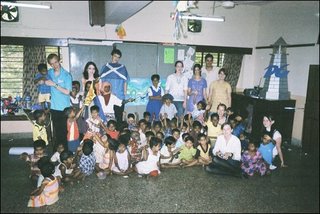The Chaos Within - Palliative Care
She didn't recognise me. She sat on the chair staring into space. Her mother spoke for her.
I asked, "How are you?"
The mother replied, "She is fine."
Me: "Are you feeling ok?"
Mother: "She has fever."
I felt her forehead. She was running a slight temperature.
Me: "A little fever, yes."
Mother: "Yes, a little fever."
A week ago Lata informed me that Saraswathi's mum had taken her to Dapodi, about an hour from Pune, despite Lata's advice that Saraswathi required special care that we believe Sahara Care Home could provide.
Yesterday Maya reported that Saraswathi's condition had deteriorated and that her mother was refusing to bring her back to Tadiwala Road for us to assess her condition. All we had to go on was what Saraswathi's daughter, who had remained behind in the community, was able to tell us.
This morning I sent Maya and Avinash to Dapodi to persuade Saraswathi's mum to let her come back to us, so that we could send her to Sahara. Avinash is good at being persuasive. By late afternoon they were at the centre en route to Wagholi. I phoned up Errol and informed him that Saraswathi is in a very poor state and required his fullest attention.
After I put the phone down, I thought of the other clients at Sahara. Clients I had met on Tuesday when I took Mahrukh Bharucha - she directs a play I'm rehearsing for at the moment - to visit Sahara. She met Errol at Easter Lunch at my house and was taken with his passion and commitment that he wears so prominently on his multicoloured sleeve.
On that visit the impossible task that Errol, Malik, Salim & Co make possible was brought home to me once again. As I sat with a man who was ravaged by TB, trying to coax him to eat, I thought 'Fuck, how does Errol do this every day?!'
We spent just under an hour at Sahara, and by the end of it, Marukh had taken a peek into life in Pune as she had never seen before: HIV+ people left to die, HIV+ people struggling to survive, HIV+ people smiling their welcomes, HIV+ people reaching out with the hand that is not paralysed to shake our own, HIV+ people who help others recover, HIV+ people sitting down to sing songs of praise to God.
I was approached by a couple of board members of Deep Griha, Dr. Onawale and Dr. Chakranarayan to explore the option of opening up a DISHA Care Home. Although I wasn't in favour of the idea, I did do the baseline survey of care facilities available to People Living With HIV/AIDS in the city of Pune.
49 beds.
16 at Asha Kiran, run by the Roman Catholic Diocese.
7 at Naidu Hospital (Govt. Run).
26 at Sahara.
That's it.
1.8% of Pune's , 5,000,000 (approx) population is supposedly HIV+ according to NACO. That's at least 90, 000 people. The answer is 49 beds. This of course does not cover the facilities available at Sassoon General. There are beds and mats for those who have no where else to go, but there is little or no attention paid to the patient, and if you are HIV+ ... then brace yourself for the very strong possibility of being stigmatised against and treated like a... like a...
Lepers, and outcastes are treated better today than someone who is HIV+.
Private hospitals also have services available for PLWHA, but none of the hospitals focus on the compassion that PLWHA require, like Asha Kiran aspires to, and Sahara does.
Arguably, if you had the money, dying in a private hospital would be preferable to dying at Sahara. At a hospital you receive better pain management. What DISHA is trying to do is get funding for Sahara so that they can provide better pain management too, and together with their compassion for the client, I believe Sahara can provide a service that rivals the best in palliative care for PLWHA.
We will pay for Saraswathi so that she receives the best possible care that Sahara can provide, but we neither have the budget nor the hope of funding currently to help Errol and his team alleviate the pain of Sahara's other clients.
To this end, I am proposing to the governing board that Deep Griha works together with Sahara, rather than go down the road of providing palliative care ourselves.
This will also break the mould in the HIV/AIDS sector where organisations are working in isolation, protective of their funding and their HIV+ clients - the reason for their funding. The focus on the beneficiary is often lost, and sadly some organisations get on the HIV/AIDS bandwagon in order to provide employment for their staff.
The reason we operate only in Tadiwala Road is because Pathway (run by Project Concern International - PCI) works in both Ramtekadi and Bibwewadi, the other two slums that Deep Griha has served since 1975 and 1984 respectively. Deep Griha refers all HIV+ beneficiaries to Pathway in these two communities.
The focus must be the beneficiary! In this case, the person living with HIV/AIDS.
The sooner we wake up to working together, the sooner an array of services - well administered and implemented - will be available for PLWHA in the city of Pune.
Have I said too much?





